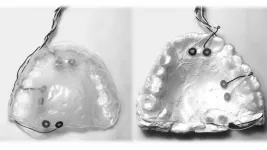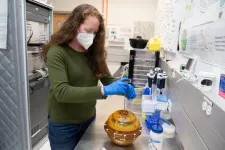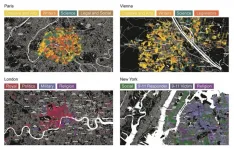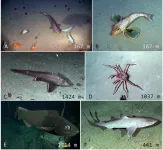Conservation aquaculture could bring more native oysters to west coast
Saving native oysters
2021-06-30
(Press-News.org) Ten estuaries on the West Coast of North America have been identified as priority locations for expanding the use of conservation aquaculture in a study led by the Native Olympia Oyster Collaborative and funded by the Science for Nature and People Partnership (SNAPP). SNAPP is a research collaboration supported by the National Center for Ecological Analysis & Synthesis (NCEAS) at UC Santa Barbara.
The study, published in Plos One, recommends locations and methods for the strategic expansion of conservation aquaculture to bring back Olympia oyster populations -- both to local estuaries where they have most declined, and into more local restaurants for oyster lovers to dine on. The authors propose using aquaculture in these estuaries -- seven of which are in California -- in a win-win scenario that supports severely declined Olympia oyster populations, while also benefiting people, including local shellfish growers and Tribal communities.
"If you've eaten oysters on the half shell anywhere on the West Coast of North America, chances are good that you've been eating one of a few species introduced to the region for just that purpose," said April Ridlon, SNAPP postdoctoral scholar, collaborative lead of the Native Olympia Oyster Collaborative (NOOC) and lead author of the study. That's partly because the oyster native to this coast, the Olympia oyster (Ostrea lurida), was overfished in the Gold Rush era, and some populations -- faced with other stressors like habitat changes and sedimentation -- never recovered.
Humans have used aquaculture -- growing aquatic animals and plants to produce food -- for millennia." The oysters served at your local oyster bar have likely been grown first in a hatchery in tanks, then put out into a bay or estuary until they reach an appropriate size to be harvested and make it onto your plate," Ridlon said. "This same process can also be used to restore declining wild populations, similar to captive breeding programs for endangered species like California Condors and Hawaiian Monk Seals. Native oysters that are raised in a hatchery can be added to local estuaries permanently to help boost their numbers where populations have severely declined. Using aquaculture techniques to support wild populations of native species is what we call conservation aquaculture."
Restoration of Olympia oyster populations doesn't always require the use of aquaculture; many projects have been implemented across the species' range from British Columbia to Baja California, without using aquaculture at all (see the NOOC Restoration Site Map). Aquaculture techniques can also pose risks, including unintended negative ecological and genetic outcomes resulting from releasing hatchery-raised oysters into wild populations, many of which aren't well understood.
This new study thoroughly evaluates the risks and rewards, and recommends aquaculture only at ten priority estuaries where using it is critical to restore oyster populations, and where the benefits clearly outweigh the risks. Two priority estuaries are in the Puget Sound region of Washington: Northern Puget Sound and Whidbey Basin; one is in Oregon: Netarts Bay. The remaining seven are in California: Humboldt Bay, Tomales Bay, Richardson Bay, Elkhorn Slough, Morro Bay, Carpinteria Marsh, and Mugu Lagoon. Aquaculture can be used to support conservation efforts at all of these sites, without growing native oysters to harvest or sell them.
At some of the priority estuaries with good water quality and a nearby hatchery, commercial aquaculture and harvest also are possible, making this tool a unique way to support both oysters and people. In these estuaries, oyster offspring produced by commercial aquaculture may be swept into the bay and settle in local wild populations, increasing their numbers. Growers may also benefit from adding a new oyster species to those that they grow -- one that is more resilient to the diseases or climate-related events that can wipe out other oyster species entirely.
In Puget Sound, where the Olympia oyster once supported the shellfish industry, many farmers are already growing the native oyster, supported by a niche market of "foodies" looking for a different flavor and the "tide-to-table" experience. "Olys -- the industry nickname for Olympia oysters -- have a unique flavor profile. They're smaller than most other oysters and pack a punch of flavor," said Shina Wysocki, owner of Chelsea Farms Oyster Bar in Olympia, Wash. "They also provide an authentic connection to the traditional foodways of the West Coast." Puget Sound Restoration Fund (PSRF) has thoughtfully engaged with commercial growers to explore conservation aquaculture of Olympia oysters in the region, and hopes to continue this approach at the two priority estuaries identified by the study: Northern Puget Sound and Whidbey basin.
"This model of partnership between growers and restoration organizations could be used in other priority estuaries to expand the toolkit for bringing native oysters back to mudflats and menus in the future," said Betsy Peabody, executive director of PSRF.
And the Olympia oyster isn't the only marine species that can benefit from using aquaculture as a tool to restore its populations. "There is a growing interest in using conservation aquaculture for marine species globally -- to support native populations of everything from kelp to abalone to giant clams," said Tiffany Waters, co-author and global aquaculture manager for The Nature Conservancy. "This kind of collaborative research is so exciting, as it can be used as a model for other species and to provide win-win opportunities for both nature and people."
INFORMATION:
ELSE PRESS RELEASES FROM THIS DATE:
2021-06-30
Even the mundane act of swallowing requires a well-coordinated dance of more than 30 muscles of the mouth. The loss of function of even one of these, due to disease or injury, can be extremely debilitating. For these people, nerve stimulation offers a ray of hope to regain some of their lost oral function.
In a new study, researchers at Texas A&M University have delineated the minimum size of electrical currents needed to provide sensation in different parts of the mouth. The researchers said their study is a first but vital step toward building electrical stimulation implants that can restore essential intraoral functions that are lost due to nerve or brain damage.
The results of the study are published in the journal ...
2021-06-30
Magnetic resonance imaging (MRI) is widely used in medicine to detect, diagnose and treat diseases such as cancer, while relying on experts' interpretation of images. Quantitative MRI, which obtains numerical measurements during the scans, can now potentially offer greater accuracy, repeatability and speed -- but rigorous quality control is needed for it to reach its full potential, according to a new study.
Researchers at the National Institute of Standards and Technology (NIST) led the study by 11 institutions comparing measurements by 27 MRI scanners from three vendors at nine clinical sites around the country. To obtain reference values and disentangle sources of bias and variation, the study used a tissue stand-in, or "phantom," originally ...
2021-06-30
A city's street names can provide a glimpse into its cultural value system and a way to quantify cultural indicators, according to a study published June 30, 2021 in the open-access journal PLOS ONE by Melanie Bancilhon from Washington University in Saint Louis, U.S., and colleagues.
Ever since named streets have existed, they have been used as a form of social engineering, mirroring a town or city's social, cultural, political, and religious values. Building off this concept in what they term "streetonomics," Bancilhon and colleagues used street names as an alternative route to quantify cultural indicators in four influential Western cities: Paris, Vienna, London, and New York.
The authors used multiple open data sources ...
2021-06-30
The deep sea Pacific Salas y Gómez and Nazca ridges are highly biodiverse and host unique fish and invertebrate taxa, according to video surveys.
INFORMATION:
Article Title: Deep-sea biodiversity at the extremes of the Salas y Gómez and Nazca ridges with implications for conservation
Funding: The expeditions were funded by the National Geographic Society and Pristine Seas donors with support to AMF. Conservation International, the Paul M. Angell Family Foundation, Tom and Currie Barron, and Alan Eustace provided additional support to DW, WG and JG. The Chilean Millennium Science Initiative Program grant #NC120030 ...
2021-06-30
In the German population, a surprisingly high 6% of under-18s are at risk of cognitive decline, falls and more from the cumulative effect of anticholinergic medications such as antihistamines and antidepressants.
INFORMATION:
Article Title: Anticholinergic burden: First comprehensive analysis using claims data shows large variation by age and sex
Funding: The authors received no external funding for this work.
Competing Interests: UH, OR, MB and JR are working at an independent, non-profit research institute, the Leibniz Institute for Prevention Research and Epidemiology - BIPS. Unrelated to this study, BIPS occasionally conducts studies financed by the pharmaceutical industry. Almost exclusively, these are post-authorization ...
2021-06-30
Researchers have developed and successfully demonstrated a novel method for studying how cells repair damaged DNA in space. Sarah Stahl-Rommel of Genes in Space and colleagues present the new technique in the open-access journal PLOS ONE on June 30, 2021.
Damage to an organism's DNA can occur during normal biological processes or as a result of environmental causes, such as UV light. In humans and other animals, damaged DNA can lead to cancer. Fortunately, cells have several different natural strategies by which damaged DNA can be repaired. Astronauts traveling outside of Earth's protective atmosphere face increased risk of DNA damage due to the ionizing radiation ...
2021-06-30
An important function of our vision is to segregate relevant figures from the irrelevant background. When we look at a visual stimulus, it drives a cascade of neural activity from low-level to higher level visual brain areas. The higher areas also provide feedback to the lower areas, where figures elicit more activity than the background, as if figures in the brain are highlighted with extra activity. Researchers from the Netherlands Institute of Neuroscience (NIN) now showed that feedback causes the extra neuronal activity in low-level areas and that the extra activity is essential for figure-ground ...
2021-06-30
MIT engineers and researchers in South Korea have developed a sweat-proof "electronic skin" -- a conformable, sensor-embedded sticky patch that monitors a person's health without malfunctioning or peeling away, even when a wearer is perspiring.
The patch is patterned with artificial sweat ducts, similar to pores in human skin, that the researchers etched through the material's ultrathin layers. The pores perforate the patch in a kirigami-like pattern, similar to that of the Japanese paper-cutting art. The design ensures that sweat can escape through the patch, preventing skin irritation and damage to embedded sensors.
The kirigami design also helps the patch conform to human skin as it stretches and bends. This flexibility, paired with ...
2021-06-30
New Brunswick, N.J. (June 30, 2021) - A Rutgers-led team of researchers has developed a microchip that can measure stress hormones in real time from a drop of blood.
The study appears in the journal Science Advances.
Cortisol and other stress hormones regulate many aspects of our physical and mental health, including sleep quality. High levels of cortisol can result in poor sleep, which increases stress that can contribute to panic attacks, heart attacks and other ailments.
Currently, measuring cortisol takes costly and cumbersome laboratory setups, so the Rutgers-led team looked for a way to monitor its natural fluctuations in daily life and provide patients with feedback that allows them to receive the right treatment at the right ...
2021-06-30
A new study based on computational analyses of how SARS-CoV-2 interacts with host cell proteins has identified 200 previously approved drugs that could be repurposed to treat COVID-19, 40 of which have already entered clinical trials. Furthermore, Namshik Han and colleagues identified 30 proteins induced by the SARS-CoV-2 virus that are targeted by 8 or more existing drugs, finding that nitric oxide production, which is important for viral synthesis, may be targeted by these drugs to fight infection. The researchers also identified 2 of these drugs with good safety profiles that successfully reduced viral replication in cellular assays, suggesting they could potentially prevent or treat COVID-19. Scientists now have sufficient ...
LAST 30 PRESS RELEASES:
[Press-News.org] Conservation aquaculture could bring more native oysters to west coast
Saving native oysters







